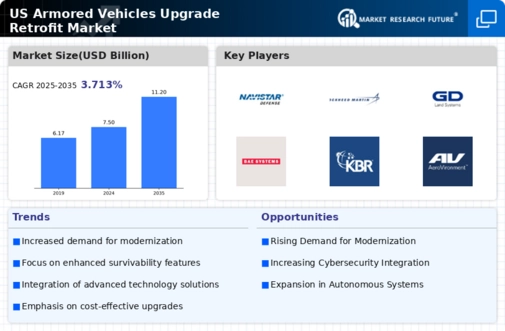Rising Threat Perception
The armored vehicles-upgrade-retrofit market is influenced by the rising threat perception among military and defense agencies. As geopolitical tensions escalate, there is an increasing need for enhanced protection and combat capabilities. The US military is prioritizing the retrofitting of armored vehicles to address potential threats from advanced weaponry and asymmetric warfare tactics. This shift in focus is evident in the growing demand for upgraded armor solutions, improved mobility, and advanced surveillance systems. The market is projected to grow at a CAGR of around 5.2% over the next five years, driven by the necessity to adapt to evolving threats. Consequently, the armored vehicles-upgrade-retrofit market is positioned to expand as defense agencies seek to bolster their operational effectiveness and ensure the safety of personnel in high-risk environments.
Increased Military Spending
The armored vehicles-upgrade-retrofit market is experiencing a surge due to increased military spending in the US. The Department of Defense has allocated substantial budgets for modernization programs, which include upgrading existing armored vehicles. In FY 2025, the defense budget reached approximately $886 billion, with a significant portion earmarked for vehicle enhancements. This financial commitment indicates a strong focus on maintaining operational readiness and enhancing the capabilities of current fleets. As military operations evolve, the demand for advanced armor, weapon systems, and communication technologies is likely to drive growth in the armored vehicles-upgrade-retrofit market. The emphasis on modernization reflects a strategic response to emerging threats, ensuring that the US military remains competitive and effective in various operational environments.
Technological Advancements in Defense
Technological advancements play a pivotal role in shaping the armored vehicles-upgrade-retrofit market. Innovations in materials science, electronics, and weaponry are driving the demand for retrofitting existing vehicles with state-of-the-art technologies. The integration of artificial intelligence, enhanced sensors, and improved communication systems is becoming increasingly vital for operational success. As the US military seeks to leverage these advancements, the armored vehicles-upgrade-retrofit market is likely to benefit from increased investments in research and development. The market is expected to witness a growth rate of approximately 6% annually, as defense contractors and manufacturers strive to provide cutting-edge solutions that enhance the performance and survivability of armored vehicles. This trend underscores the importance of staying ahead in a rapidly evolving technological landscape.
Increased Collaboration with Private Sector
The armored vehicles-upgrade-retrofit market is witnessing increased collaboration between the military and private sector companies. This partnership is essential for leveraging innovative solutions and technologies that enhance the capabilities of armored vehicles. Defense contractors are increasingly involved in the retrofitting process, providing expertise in advanced materials, systems integration, and modernization strategies. The US military's emphasis on public-private partnerships is likely to accelerate the pace of innovation within the armored vehicles-upgrade-retrofit market. As these collaborations expand, the market may experience a boost in the development of tailored solutions that meet specific operational requirements. This trend indicates a shift towards a more integrated approach to defense procurement, fostering a dynamic environment for advancements in armored vehicle capabilities.
Focus on Sustainability and Lifecycle Management
The armored vehicles-upgrade-retrofit market is also being shaped by a growing focus on sustainability and lifecycle management. As military organizations aim to reduce their environmental footprint, there is an increasing emphasis on retrofitting existing vehicles rather than procuring new ones. This approach not only conserves resources but also extends the operational life of current fleets. The US military has initiated programs aimed at enhancing the sustainability of its operations, which includes retrofitting armored vehicles with more efficient systems and components. This trend is likely to drive demand in the armored vehicles-upgrade-retrofit market, as organizations seek to balance operational effectiveness with environmental responsibility. The potential for cost savings and improved efficiency further supports this shift towards sustainable practices in defense procurement.






















Leave a Comment